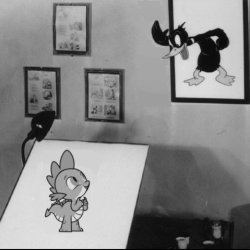
Credits & Acknowledgements
A lot of people can say that Friendship Is Magic got them through a rough patch in their lives. Being a few decades older than those people, I instead say that Looney Tunes and Merry Melodies got me through my rough patch. (I’m referring to the TV airings in the 1980’s, not the theatrical airings in the 1930’s—how old do you think I am?) The two series were created by Leon Schlesinger in 1930 to compete against Disney’s Mickey Mouse and Silly Symphonies series: Looney Tunes cartoons were character-driven and remained in black & white until 1943; Merry Melodies used one-off casts of characters to act out songs from Warner Bros.’ vast catalog and was in color starting in 1934. By the time both series were in color, they had become interchangeable.
Daffy Duck was created for the cartoon “Porky’s Duck Hunt” in 1937—Porky was the outstanding star of Looney Tunes during the brief period from ’35 to ’37, but he was soon eclipsed, first by Daffy and then by Bugs Bunny starting in 1938. (Link is to just the ending of the cartoon, as Daffy wasn’t really in his first cartoon very much.) “Duck Hunt”’s director was Tex Avery, and his Animator was Bob Clampett, who soon rose to become a director himself. His Voice—the Voice of most Warner Bros. cartoon characters—was Mel Blanc. (A great Daffy Duck cartoon of Clampett’s is “The Daffy Doc” from 1938.)
At first Daffy and Bugs were equally-annoying characters, but under Clampett, Bugs was the wily one, while Daffy was straight-out insane, often bouncing around the screen with his distinctive “woo-hoo”s. By around 1950 he had evolved into the form that you probably know him as, the “Chuck Jones” Daffy: always second to Bugs Bunny, perpetually jealous and insecure. Jones once said that “Bugs is who we want to be. Daffy is who we are.” I find this version of Daffy very funny, but then I feel uncomfortable afterwards in how much like him I am. I think the definitive Jones Daffy quote came from the minor cartoon “The Abominable Snowman” to justify why he is yet again trying to murder Bugs: “It’s a simple matter of logic. I’m not like other people. I can’t stand pain. It hurts me.” So I welcomed the chance to write for the happier version of the character.
Animation in the Silent Era frequently involved cartoon characters interacting with live-action surroundings and even fighting with their creators. This became much less common in the Sound Era. “You Ought to Be In Pictures”, made in 1940, is one of those rare Sound Era live-action-and-animation films, and was directed by Fitz Freleng. It directly capitalized on Porky Pig’s fall from popularity: the story is set in the Leon Schlesinger and Warner Bros. studios, and is about Daffy convincing Porky Pig to walk out of his “cartoon contract” so he can be a movie star opposite Bette Davis (“for three grand a week!”). And as soon as he leaves to fruitlessly try to get a part at Warner Bros., Daffy steals Porky’s spot as the star toon with Schlesinger.
The character of Dodo comes from the Bob Clampett cartoon “Porky in Wackyland”, from 1938. Porky’s a world explorer who seeks the “last of the do-do’s” for a huge cash reward. He finds the creature in an insane world where anything can happen. He was Animated by a team, but I saw the most footage from Izzy Ellis and Bobo Cannon. He was Voiced by Mel Blanc, of course.
Tiny Toon Adventures was an American animated series for television, originally airing from 1990 to 1992, created by Tom Ruegger and produced by Amblin Entertainment and Warner Bros. Animation. It’s about a group of second-generation toon characters who attend Acme Looniversity in order to learn how to take over as the next stars of the Looney Tunes. The classic characters from the theatrical cartoons had cameos as professors at the university. Gogo Dodo was a decidedly minor character styled after the character from “Porky in Wackyland”.
Animaniacs was a follow-up series by Amblin and WB, running from 1993–1998. It was arranged as a variety show, with separate casts for each segment that rarely interacted with each other. Wakko, Yakko and Dot Warner were the stars. Slappy Squirrel and her grand-nephew Skippy were in their own segment: Slappy was a grouchy retired toon from the 40’s, and Skippy was too innocent for this world. Most of the episodes involved Slappy easily outsmarting and cartoon-maiming her many geriatric enemies, all coming from the ”old days” when she was “Slappy the Slap-Happy Squirrel”. The character was largely inspired by Screwy Squirrel and other short-lived Tex Avery characters. I couldn’t tell you who Slappy’s original Artist was, but her creator, Voice and writer were all the same person: Sherri Stoner.
The story is set during the period when Lauren Faust (yes, I actually know her last name) was transitioning out of her position as chief executive for Friendship Is Magic, and coincidentally the studio changed from being Studio B to DHX Studios Vancouver. It is my personal opinion that while the show that continued carried over a great deal of Faust’s best ideas, that something fundamental was abandoned during the transition, pushing a mostly-slice-of-life show down the inevitable path of being an epic adventure show with occasional slices of life to set up the next adventure. I was and am fully on board with this change, but I am at least a little curious about what would have happened if Lauren Faust had never left, other than the fact that the show would almost certainly have been cancelled by Hasbro before it reached 65 episodes.
Oopy was from the completely-forgotten (and mostly-rightfully so) Scrappy cartoons (1931–1941), created by Dick Huemer for Charles Mintz’ Screen Gems Studio and distributed by Columbia Pictures. Scrappy was a dull little boy who let his imagination get away from him. His frequent antagonist was a bratty little baby originally called Vonzy, but later Oopy.
Popeye the Sailor and Betty Boop belonged to the Fleisher Studio, which became Famous Studios, and they eventually became Warner Bros. property. She was Animated by Grim Natwick. Her original Voice was Maggie Hines, but many individuals voiced her afterwards, most commonly Mae Questel in her hayday. Betty is far better known nowadays for her merchandise than for her original cartoons—which were all in black & white (with one exception)—and nobody remembers that she was “domesticated” by the Code in 60 of her 126 appearances. I can’t stand those post-Code cartoons. Nobody can. As a way to link this story with “Discord’s Equestria Control Room”, Koko the Clown co-starred with Betty in several of her most-surreal pre-Code cartoons, including “Minnie the Moocher” (1932) and “Snow White” (1933).
Horace Horsecollar: For a brief period, the Mickey Mouse series was supposed to be about a group of anthropomorphic farmyard friends hanging out together. So that meant you had to have horse (Horace) and cow (Clarabelle Cow) characters. Clarabelle still shows up from time to time, but you rarely see Horace anymore, simply because he was nothing but a boring straight-man.
The Pincushion Man was the antagonist from this weird 1935 Ub Iwerks animated short named “Balloon Land”. Considering the main characters are living balloons, Pincushion is clearly a serial killer, and he is quite clearly killed at the end of the film by the balloon people in retaliation for his reign of terror. In other words, you really ought to watch it—it’s good wholesome fun!
“We don’t talk about Skippy”: No, no, no, no, no.
“Nice rainbow you just summoned over your head.”: Because the more you know...
Flip the Frog: Walt Disney’s artist partner Ub Iwerks was lured away from his side by Pat Powers in 1930 to found his own studio and make cartoons for MGM. (This was before MGM formed their own studio and created Tom & Jerry.) Just like with Schlesinger, Iwerks made two series: Flip the Frog with a constant cast of characters, and the fairytale-inspired ComiColor Cartoons, where all of the characters were one-offs (and some of them were serial killers). Flip was one of many characters created at the time designed to steal Mickey Mouse’s limelight; none of them succeeded. The Flip cartoons are a little weird, because Ub Iwerks is a little weird. After his studio inevitably failed he and Walt Disney reconciled. Iwerks turned his attention to technical innovations, and became known for the multi-plane camera, which he used in animated shorts and films to create a three-dimensional feeling. (Between Flip flopping and Iwerks Studio folding, there was also Willie Whopper, a better version of Scrappy.)
The Hays Code (officially known as the “Motion Picture Production Code”) was created in 1929, adopted in 1930 and named after Will H. Hays, president of the Motion Picture Producers and Distributors of America. It was created as a means by which the movie studios could police themselves before the blue-noses got mad enough to impose government censorship on the industry, which the Supreme Court in 1915 had already decreed they could legally do anytime they wanted to. The Code had no teeth until 1934, when Joseph Breen became the head of the Production Code Administration and amended the Code to say that his office had to put their stamp of approval on every film made in Hollywood, or no theater in America would show it. The amendment went into force on July 1, 1934, and that was the day that Betty Boop cartoons started sucking. The “Code Era” ended on November 1, 1968, when the MPAA film rating system went into effect. Between 1934 and 1968, every movie and short made was effectively G-rated. Oh and I suppose I need to go on the record and say that I do not believe that Joseph Breen sold his soul to a demon in order to control what every moviegoer in America would be allowed to think, and I certainly don’t think that he was then murdered and replaced by the demon Astaroth.
Speaking of which...Astaroth is a Great Duck Duke of Hell, included in several catalogs of demons written over the centuries. In one of these catalogs, he is said to exploit human laziness, self-doubt and “rationalized philosophies”, the last of which made him perfect for my use. The “Star of Astaroth” is the McGuffin in the Disney musical Bedknobs and Broomsticks (1971), a favorite of mine growing up. He’s name-checked in the 1976 Hammer Horror film To the Devil a Daughter. He is the spirit that animates the title character in the influential Silent horror film The Golem: How He Came Into the World (1920). He’s been in lots of other books, movies, television series and video games, but those are the ones I’m most-familiar with.
Angel Bunny is a demon. I don’t think anybody disagrees with that. They merely differ in which demon he is.
Chapter 2 begins with a lengthy quote from the transcript of the episode “The Return of Harmony Part 2”, written by M.A. (Mitch) Larson. It aired on September 24, 2011.
Lauren Faust created My Little Pony: Friendship Is Magic in 2009, with the first episode airing in October of 2010. With the airing of the final episode of Season 1 in May of 2011, Faust announced that she was transitioning from executive producer to consulting producer, and with the Season 2 finale in April of 2012, she left the show altogether. The parting was almost-certainly amicable and planned from the start, which has not stopped the more fanatical fans (such as myself) to assign solid reasons why she chose to leave—I put those arguments in Fluttershy’s mouth.
G1 Spike was created for My Little Pony: The Movie (1986), directed by Michael Joens. As usual for modern animation, it’s nearly impossible to tell who first Animated any character. His original Voice was Charlie Adler. For G4, his Voice was Cathy Wesluck and I’m going to say he was Animated by Lauren Faust.
Other Friendship Is Magic characters: Rainbow Dash and Applejack Voiced by Ashleigh Ball. Fluttershy and Pinkie Pie Voiced by Andrea Libman. Rarity Voiced by Tabitha St. Germain. And Twilight Sparkle Voiced by Tara Strong. All of these characters (plus Angel) presumably designed by Lauren Faust, even if she might not have personally Animated them.
Meghan: Meghan McCarthy, beloved writer for the show and eventual script editor. She also wrote the script for the original Equestria Girls movie.
“Duck! Rabbit, Duck!” is a 1953 cartoon directed by Chuck Jones and written by Michael Maltese, in which Bugs and Daffy continually try to confuse the hunter Elmer Fudd, efforts that inevitably end with Daffy’s beak being blown off of his head by gunfire. “Duck season” of course is a phrase that will stick in the head of anybody who’s seen that cartoon. (Chances are high that the above link is already dead. Look for a video of the cartoon that is 6 minutes and 51 seconds long, and not pitch-shifted or altered in some other way that ruins the jokes.)
“You’re going to trash Mitch, aren’t you?”: M.A. Larson would eventually write “Magical Mystery Tour”, the episode where Twilight would get her wings. At the time, this made many people very angry and was widely regarded as a bad move. He had a checklist.
Rob: Rob Renzetti. The executive producers of Friendship Is Magic for Season 2 are not as well known to the fans as Lauren Faust (Season 1) or Meghan McCarthy (Seasons 3–5 & 8). So I used Renzetti instead. He was the story editor, and therefore not the guy with the authority to cancel a contract. Over the years he has worked on a lot of shows, including The Powerpuff Girls, Samurai Jack, Foster’s Home for Imaginary Friends, Gravity Falls and his current series Kid Cosmic. He was the creator of My Life as a Teenage Robot.
Smaug: Character from The Hobbit (1937), written by J. R. R. Tolkein.
All of those 2011 movies: OK you know what? I’m tired, and I don’t think I have any interesting quips, so can we just skip the movie credits, just this once? Because otherwise I’ll be up for another six hours researching them all. They all either came out in 2011 or were made in 2011—let’s leave it at that.
Jack, Spiro and Justin: Stunt coordinator Jack Gill, stunt director Spiro Razatos and overall director Justin Lin, all associated with Fast Five. I probably got lots of things wrong with this scene; I never saw any of the Fast & Furious films.
“The Ink and Paint Club”: Inking and painting are the first two steps in creating an animation cell. There was also a Disney Channel show with this name that aired in the wee hours of the night between 1997 and 1998; it included lots of theatrical Disney cartoons and I ate that show up like candy.
Cathy: Cathy Wesluck is Spike’s voice actress.
Monty Python: Used to set up the “how not to be seen” reference.
The Real Ghostbusters was an American animated series for television, running from 1986–1991, based on the 1984 film Ghostbusters. (The “Real” was in the title because Filmation had an unrelated 1975 series called “The Ghost Busters”, and they refused to hand over the TV rights to that name, even making a revival animated series with the goal of tricking Ghostbusters film fans into watching it.) It was produced by DIC Enterprises and Columbia Pictures Television. The show devolved in quality after the third season, ending up as a vehicle for the childish character of Slimer by 1988. Writer J. Michael Straczynski (yes, that J. Michael Straczynski) was the story editor for the first (good) season and wrote many of the best-regarded of the episodes, such as “Collect Call of Cathulu [sic]”. That and many other episodes in the early seasons were well-researched to include supernatural beings from both folklore and well-known fiction.
“Gertie the Dinosaur” (1914) starred the first cartoon character that could really be said to “come to life” in the minds of the audience, despite not saying a single word. The 12-minute film was entirely drawn by the newspaper cartoonist Winsor McCay in order to escape the hell of his day job: creating editorial cartoons expressing opinions he despised for the Hearst Newspaper Syndicate. (An assistant handled the stationary background of the short.) I always say: If you’re going to create an alternate universe, always be sure to work out the origin event when history started diverging, even if you have no intention of revealing that moment to your readers.
Sam: Sam Raimi, director of Oz, the Great and Powerful (2013, but filmed in 2011). Spike references his horror films (The Evil Dead, 1981) and Spider-Man (2002).
Mary Lynn: Yes, I made her up. Rainbow Brite was a huge inspiration, though.
Broom—: Broom-Hilda is a comic strip about a witch. It’s been running since 1970. The character has appeared in television animation three times, as an ensemble player: Archie’s TV Funnies (1971), Fabulous Funnies (1978) and The Fantastic Funnies (1980).
Kathy: Kathleen Barr. Her career as a voice actress dates back to 1979, which is why I dated the Mary Lynn cartoons when I did. It would really be more accurate to say that her continuous career in American animation started in 1992, but I needed Trixie to be older than that.
Tara: Tara Strong. A bigger contrast between real-life person and voiced character could not be conceived than that between Tara Strong and Twilight Sparkle. Except when Twilight was insane.
Tegan: Tegan Jovanka, fictional companion to the main character of Doctor Who between 1981 and 1984, played by Janet Fielding. Tegan was a stewardess for “Air Australia” who hailed from Brisbane, Australia.
Peter: Peter Jackson, director of both the Lord of the Rings movies and the Hobbit movies.
Weta: Weta Digital, the special effects company used by Peter Jackson. It changed its name to Weta FX in 2021.
Laketown and the Lonely Mountain: Laketown is the name of the town that Smaug burns in The Hobbit. Smaug lives inside the Lonely Mountain.
Pinkie Pie: A new origin for every time I use the character...check!

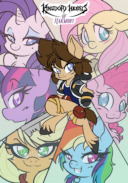

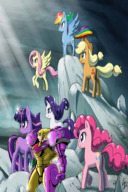


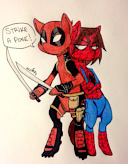
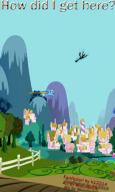
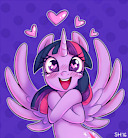
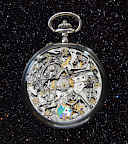

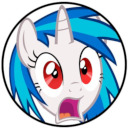
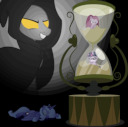




Great story, wished I could've been there with Spike.
This right here is everything I loved and more about "Who Framed Roger Rabbit?" and other similar stories about 'Toons interacting with reality the way human actors and actresses do. The history behind each significant character and their personalities on and off set are so well written and fitting that its like I'm watching the episode in my mind! The older characters feel as old as they are while still fitting their characterization and extrapolating how things go after they've 'retired'.
The subtle and not so subtle world-building behind the AU is fantastic and I'm so glad you included most of the major historical studios and not just Disney/WB. I shudder to think of that hypothetical season 2 that might have been, cause its way too easy to see a studio pulling that kinda thing.
The humor is top notch and well executed. If I didn't know any better I'd think I was reading the novelization if an actual movie!
For me, this is an instant favorite, regardless of the contest.
This is really good.
Windsor McCay got his start with the Little Nemo comic strip. I'd say he was probably the 3rd most influential cartoonist of the 20th century (behind Hanna/Barbara & the guy with the mouse).
I'd also give a shout out to Mel Blanc who was the voice of over 400 cartoon characters.
11215877
You made me realize that I should have been providing Artists and Voices for all of my main characters, in accord with the worldbuilding. So now Mel and a lot of other folks have been credited.